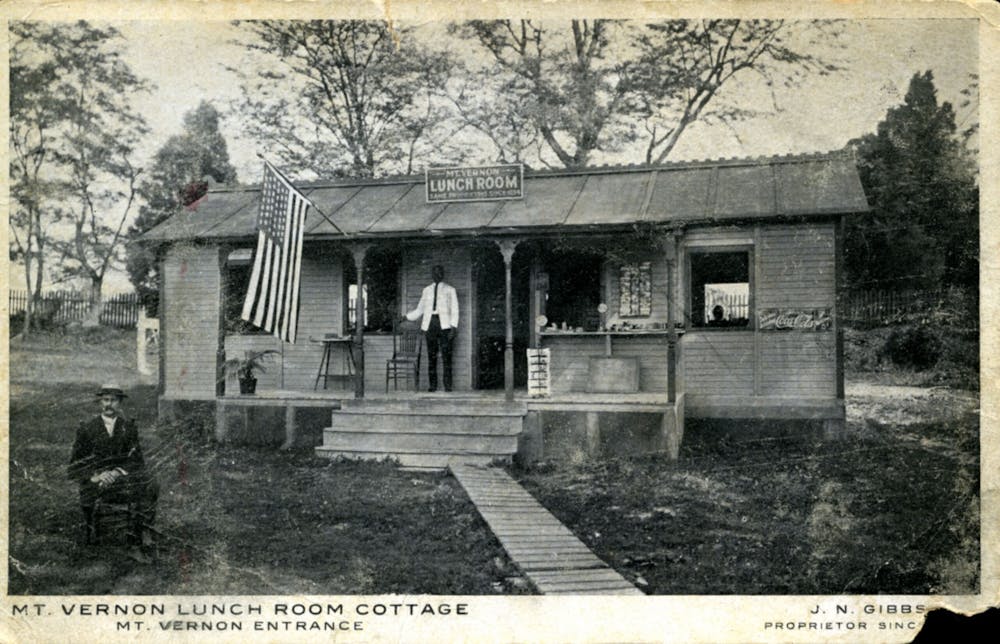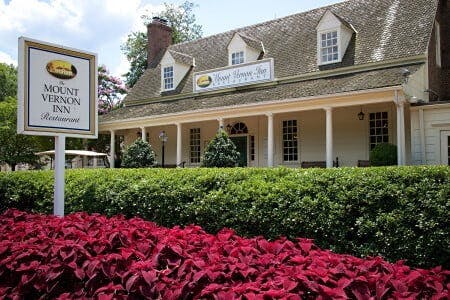About Us
Offering hospitality since the 18th century
The Mount Vernon Inn Restaurant is located on the grounds of George Washington's estate.
An admission ticket to the estate is not required to dine.
For dine-in service, reservations are recommended but not required.
In 1798, the Washingtons welcomed 670 overnight guests, who were wined and dined in what one guest described as "the genteelest manner."
George Washington died in 1799 and the generations who followed had to deal with living in a home that was rapidly becoming a tourist attraction. With visitation increasing to as many as 10,000 visitors each year, and Virginia facing an economic depression, the family’s financial well-being suffered.
In 1853, a group of patriotic women banded together to form the Mount Vernon Ladies' Association, which raised the funds to purchase the dilapidated Mansion from Washington's descendants.
The Association opened Mount Vernon to the public soon after the purchase agreement was signed in 1858 and the long restoration process began.
A small staff, headed by secretary Sarah Tracy and superintendent Upton Herbert, shared the responsibility for opening the doors and conducting tours, even while the Civil War raged just a few miles away.
Because Mount Vernon's location was miles from the nearest tavern or restaurant, Tracy and Herbert provided light refreshments at Washington's home, often setting up a simple table just outside Washington's kitchen.
The additional income, though tiny by today's standards, helped to keep the Association solvent. Mount Vernon's entire income in 1864 was $348.03.

Attendance grew by leaps and bounds.
Just east of the entrance to Mount Vernon, the Gibbs Family owned and operated a simple restaurant specializing in "Virginia chicken." In addition, the trolley supplied enough visitor traffic to support a "beer hut" adjacent to the restaurant.
Concerned citizens (as well as several Mount Vernon board members) complained that the facilities were not in keeping with the dignified shrine located just a few yards away, but there was little recourse—the establishments were just over the Mount Vernon property line.
A Pit Stop on the George Washington Memorial Parkway
The next transformation took place in 1931-32 when the nation celebrated Washington's 200th birthday by opening the George Washington Memorial Parkway from D.C. to his home.
Although cars and buses soon replaced horses and trains, Mount Vernon continued to offer visitors another option—they could travel from Washington and Old Town Alexandria by boat.
Once again, visitation skyrocketed, and so did the need for a dining establishment.
The federal government purchased the land outside Mount Vernon's gates when it negotiated the right-of-way required to construct the parkway, with the specific goal of providing refreshments to weary travelers. At the exact same site where the Mount Vernon Inn rests today, a small restaurant opened its doors, owned by the National Park Service.
By 1964, visitation to Mount Vernon had reached a phenomenal 1.3 million people, which was the all-time record for the highest annual attendance for a historic home in America. The restaurant and gift shop complex was expanded and then expanded again.
The Grand Opening of the Mount Vernon Inn
In the early 1980s, the Association decided that dining was an important part of the overall Mount Vernon experience and the only way to ensure quality was to enter the full-service restaurant business themselves.
Mount Vernon bought the concessionaire contract of the national restaurant firm that managed the Inn and hired a seasoned chef. Although visitors responded enthusiastically to the improved food and service, the early years were rocky. As the gift shop and snack bar flourished, the restaurant struggled to break even.
In 1985, Mount Vernon's board decided to open the Inn for dinner with a new, upscale menu. Again, during the first three years, ledgers were swimming in red. Mostly by word of mouth, the restaurant's reputation for good food in a cozy atmosphere, with reasonable prices, began to take hold with the local residents.
The Inn developed a new niche as a "special occasion" destination, and bookings for wedding receptions, holiday parties, and corporate dinners increased dramatically.

Evolution of the Snack Bar
While the restaurant found its footing, the straightforward snack bar consistently turned a profit in the early 1990s. But as Americans' taste in fast food began to change, sales became stagnant.
Visitor surveys revealed that Mount Vernon's cafeteria-style service offered too few choices.
With only a handful of indoor seats, visitors complained that there was no place to sit and eat, especially in winter.
Visitor surveys strongly influenced the Association's decision to transform the snack bar into a food court. It became clear that mom, dad, and the kids were not all looking for the same meal. The food court concept provided the freedom of choice to people of all ages and persuasions.
A Return to Form
Once again, hospitality at the Inn, with its larger full-service restaurant and a six-station food court, now rivals that of George and Martha Washington.
What has changed the most, perhaps, is the pace of eating.
In the 18th century, the "dinner hour" at Mount Vernon could last well over an hour. Modern visitors to the Washington region move at a comparatively breakneck pace.
The Food Court Pavilion will satisfy this need to grab and go. And for those looking to step back into the more tranquil atmosphere of the 18th century, the Inn Restaurant is right next door.
